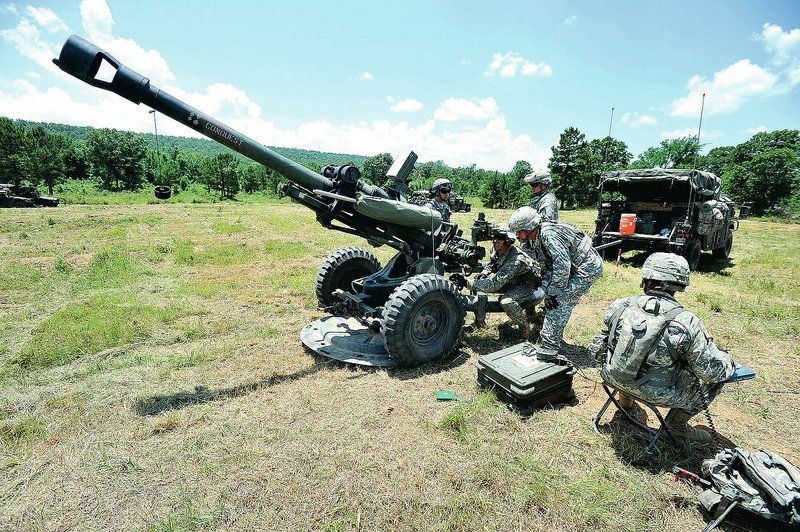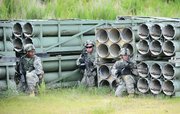FORT CHAFFEE -- A platoon comprising 30 to 40 Arkansas National Guard infantrymen crept out of the tree line surrounding a simulated village Friday morning as a mock enemy threw smoke bombs to signal an attack, creating plumes of pink, green and yellow.
Soldiers divided up and ran to each of about a dozen buildings. Their goal was clearing enemies while leaving "citizens," acted out by hired role players, uninjured. The crackle of their weapons, firing blanks, echoed off nearby hills.
The exercise -- located at Fort Chaffee, a 65,000-acre military training area near Fort Smith -- culminated at the village's largest structure. Most members of the platoon gathered around the building, and one soldier attempted to toss a deactivated grenade into a top-floor window.
It landed on the building's metal roof with a clunk.
On his second try, the grenade flew into the window.
"He got it," said Lt. Col. Joel Lynch, spokesman for the Arkansas National Guard, who was watching from above. "See, that's why we practice."
Approximately 3,000 soldiers in the Arkansas National Guard's 39th Infantry Brigade Combat Team gathered at Fort Chaffee this month to go through their annual training, which keeps them prepared for deployment.
The 39th makes up almost 45 percent of the state's Army National Guard, and its units are spread throughout 37 Arkansas counties.
This year's training, which started at the beginning of June, is not a regular rotation, said Lt. Col. Dwight Ikenberry, operations officer at Fort Chaffee. The soldiers are practicing combat for 20 days -- about a week longer than the usual summer training -- and the number of exercises and participants is larger than usual.
The special rotation of training is called the eXportable Combat Training Capability -- what Lynch called the "Superbowl" of military training events.
Four of the Army's 28 Infantry Brigade Combat Teams -- including Arkansas' 39th -- will go through the eXportable Combat Training Capability this summer. Similar events are currently being held at Camp Ripley, Minn., and Fort Sill, Okla. They'll be held later this summer at Fort Drum, N.Y.; Camp Shelby, Miss.; and Camp Grayling, Mich.
"If you're lucky, you get it," Lynch said. "We have annual training, but with the explosives, artillery and civilians on the ground -- this doesn't happen too often. This is kind of the big game for this brigade."
Along with the 39th, portions of the Arkansas National Guard's 87th Troop Command are training, as are soldiers with the 138th Infantry Regiment of the Missouri National Guard.
Mock enemy forces are played by a 500-person battalion of the U.S. Army's 101st Airborne Division out of Fort Campbell, Ky.
Throughout the training, representatives from the active-duty Army's 181st Infantry Brigade out of Fort McCoy, Wis., are providing instruction to soldiers and evaluating each mission.
At any given time, more than 20 separate exercises are being conducted, said Capt. Nathan Perry, a public affairs officer with the 39th Infantry Brigade Combat Team. The exercises include shooting howitzers, defending against enemy attacks and practicing an evacuation in mass-casualty situations.
Miles away from the simulated village Friday, a field artillery platoon of the 39th practiced firing 105mm howitzers. Seven-person teams shot multiple rounds out of four howitzers, aiming for a target near Potato Hill -- an impact area on the east end of the post.
The rounds were in the air for about 30 seconds and 6 miles before landing.
"We can put our round within 5 meters of the target; that's our kill radius," said Capt. Christopher Alexander, who is in charge of eight of the unit's howitzers. "That's how accurate we can be. The pressure through the air, the rotation of earth, the rotation of round -- it all gets calculated."
Some of the exercises, such as the ambush of the simulated village, are modeled off of combat during the wars in Iraq and Afghanistan, said Lt. Col. Vixen James, training site manager at Fort Chaffee.
"All of us went through situations where we had to go into buildings and clear them," he said. "There was a shortcoming at installations to train for that before we got into those situations."
Staff Sgt. Lance Gainey of Fouke served in Iraq. After participating in the exercise at the village Friday morning, he said it was "as close as you can get to being in a combat scenario."
"It's very realistic," Gainey said. "As far as the challenging part -- it's training the new guys. It's getting them up to par."
On Friday morning, a handful of large white pole tents stood on the west side of Fort Chaffee, surrounded by dozens of smaller tents. Altogether, they serve as makeshift living quarters for the 39th.
With the extra people on base -- including the hundreds of workers it takes to set up and run the special training rotation -- the post's permanent barracks had been filled, Ikenberry explained.
Directors of the eXportable Combat Training Capability ran the event out of a nearby mobile home-like structure one unit leader jokingly referred to as the "Star Wars building."
A table of computers faced a large screen, on which a map of Fort Chaffee was projected. Rotation Director Scott Sarver zoomed in to groups of blue, white and red dots, denoting soldiers, civilians and enemies. As he zoomed closer, individual people, with their names and ranks hovering below them, could be identified.
Sarver watched as one soldier in the simulated village ran out of a building and joined the rest of his platoon across the street from the enemy.
He explained that each soldier was outfitted with a personal GPS, about the size of a small radio, that unit leaders could use to locate, record and evaluate them.
"You can see them out in their training areas," Sarver said. "We know who they're shooting and when and exactly where they're at."
The training rotation will end June 21.
Exercises in the first few weeks are leading up to larger-scale final missions, Perry said.
"A few platoons are coming together and growing into company-size," he said. "We're training and learning now, so we can be proficient and execute when we're needed."
Metro on 06/13/2015

